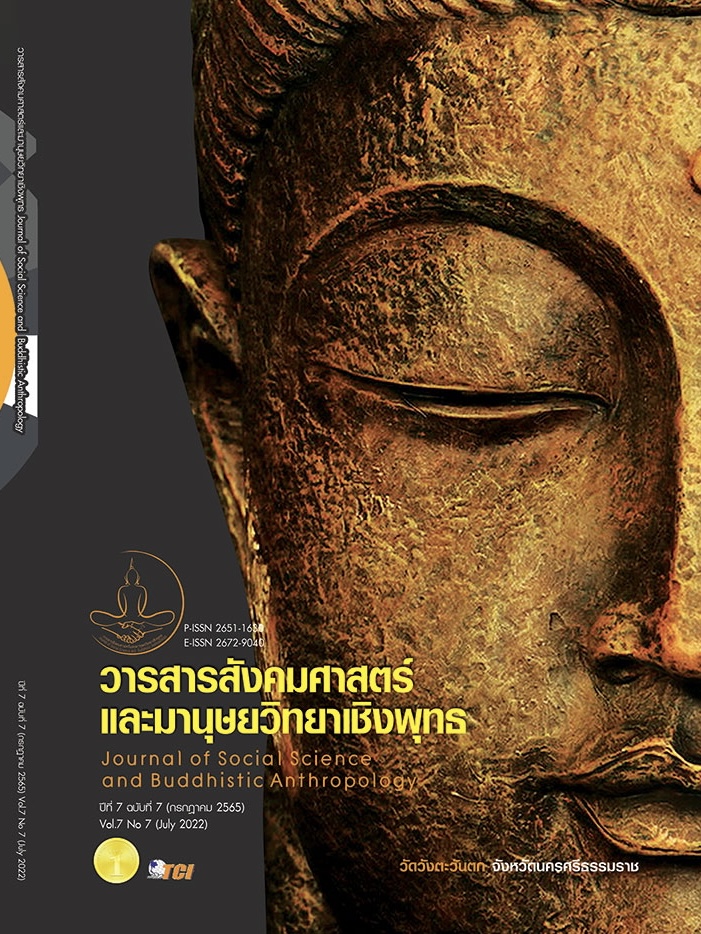THE MEASUREMENT MODEL OF SAFETY BEHAVIOR OF FIRE AND RESCUE OFFICER
Keywords:
Measurement Model, Confirmatory Factor, Safety Behavior, Fire and Rescue Officer, Empirical DataAbstract
The Objectives of this research article were to analyze and investigate the validity of safety behavior measurement model of Fire and Rescue Officer with empirical data. The study was quantitative research. The research samples were 200 people from Fire and Rescue Brigade Division 1, 2 and 4 at Bangkok Fire and Rescue Department. The sampling method was Multi-stage Random Sampling. The research instrument had content validity (The item objective congruence: IOC) between 0.60 - 1.00, the item discrimination was between 0.439 to 0.736 and the overall reliability was 0.926. Data were analyzed by confirmatory factor analysis. The results indicated that the safety behavior measurement model of Fire and Rescue Officer fitted with empirical data: Chi-Square = 154.309 df = 133, p = 0.100, Relative Chi-square (Chi-square/df) = 1.160, Root Mean Square Error of Approximation (RMSEA) = 0.028, Standardized Root Mean Square Residual (SRMR) = 0.064, Normed Fit Index (NFI) = 0.955, Non-Normed Fit Index (NNFI) = 0.989, Comparative Fit Index (CFI) = 0.992. Safety behavior measurement model consists of 2 components. Safety compliance had the standardized factor loadings of 0.898. The standardized factor loadings of 7 observed variables were statistically significant at the level of .01 level, and they were from 0.425 to 0.712. Safety participation had the standardized factor loadings of 0.706. The standardized factor loadings of 12 observed variables were statistically significant at the level of .01 level, and they were from 0.449 to 0.751.
References
กรมป้องกันและบรรเทาสาธารณภัย กระทรวงมหาดไทย. (2553). คู่มือการปฏิบัติงาน เจ้าพนักงานป้องกันและบรรเทาสาธารณภัย. เรียกใช้เมื่อ 5 ธันวาคม 2563 จาก http://law.disaster.go.th/ upload/minisite/file_attach/201/5f90fafe7bfca. pdf.
คณะกรรมการข้าราชการกรุงเทพมหานครและบุคลากรกรุงเทพมหานคร. (2560). มาตรฐานกำหนดตำแหน่ง. เรียกใช้เมื่อ 12 สิงหาคม 2563 จาก http://office. bangkok. go.th/csc/images/ Files/files/standart_position/7engineer/3-7-002-n.pdf.
คณะกรรมการจัดทำแผนป้องกันและบรรเทาสาธารณภัย กรุงเทพมหานคร. (2558). แผนการป้องกันและบรรเทาสาธารณภัย กรุงเทพมหานคร พ.ศ.2558. เรียกใช้เมื่อ 23 ตุลาคม 2564 จาก http://www.oic.go.th/FILEWEB/CABINFOCENTER9/ DRAWER016 /GENERAL/DATA0000/00000026.PDF.
ชูศรี วงศ์รัตนะ. (2553). เทคนิคการใช้สถิติเพื่อการวิจัย. (พิมพ์ครั้งที่ 12). กรุงเทพมหานคร: คณะศึกษาศาสตร์ มหาวิทยาลัยศรีนครินทรวิโรฒ.
นริศ สีหะรัตน์. (2556). การประเมินตนเองในการปฏิบัติงานของเจ้าหน้าที่ดับเพลิง สำนักป้องกันและบรรเทาสาธารณภัย กรุงเทพมหานคร. ใน วิทยานิพนธ์ศิลปะศาสตร มหาบัณฑิต สาขาวิชารัฐศาสตร์.
มหาวิทยาลัยเกษตรศาสตร์.
Burke, M. J. et al. (2002). General safety performance: A test of a grounded theoretical model. Personnel Psychology, 55(2), 429-457.
Chughtai, A. A. (2015). Creating safer workplaces: The role of ethical leadership. Safety Science - Journals, 73(1), 92-98.
Comrey, A. L. & Lee, H. B. (1992). A First Course in Factor Analysis. (2nd ed). Hillsdale, New Jersey: Lawrence Erlbaum Associated.
Field, A. (2005). Discovering Statistics Using SPSS. (2nd ed). London: Sage Publications, Ltd.
Freaney, C. (2011). Safety Culture and Safety Behaviors Among Firefighters. In Doctoral Dissertations Health and Human Sciences. University of Tennessee.
Hooper, D. et al. (2008). Structural Equation Modelling: Guidelines for Determining Model Fit. The Electronic Journal of Business Research Methods, 6(1), 53-60.
Lu, C. S. & Yang, C. S. (2010). Safety leadership and safety behavior in container terminal operations. Safety Science, 48(2), 123-134.
Murphy, K. R. & Davidshofer, C. O. (1988). Psychology Testing Principles and Applications. (6th ed). New Jersey: Pearson Education.
Neal, A. & Griffin, M. A. (2006). A study of the lagged relationships among safety climate, safety motivation, safety behavior, and accidents at the individual and group levels. Journal of Applied Psychology, 91(4), 946-953.
Szubert, Z. & Sobala W. . (2002). Work-related injuries among firefighters: sites and circumstances of their occurrence. International Journal of Occupational Medicine and Environmental Health, 15(1), 49-55.
Turner, N. et al. (2012). Job Demands–Control–Support model and employee safety performance. Accident Analysis & Prevention, 45(1), 811-817.
Zhang, J. & Wu, C. (2014). The influence of dispositional mindfulness on safety behaviors: A dual process perspective. Accident Analysis and Prevention, 70(1), 24-32.
Zhang, J. et al. (2013). Task complexity matters: The influence of trait mindfulness on task and safety performance of nuclear power plant operators. Personality and Individual
Differences, 55(4), 433-439.
Downloads
Published
How to Cite
Issue
Section
License
Copyright (c) 2022 Journal of Social Science and Buddhistic Anthropology

This work is licensed under a Creative Commons Attribution-NonCommercial-NoDerivatives 4.0 International License.








